Papers and Presentations - 2018
August
NIF Reveals How Hydrogen Becomes Metallic in Giant Planets
Experiments Reveal New Details Inside NIF Implosions
Connecting the ‘Dots’ to Measure Energy Flow in NIF Hohlraums
Meteorologists need to keep an eye on atmospheric temperature fluctuations to predict the strength and direction of tropical storms and hurricanes, as well as everyday weather. In the same way, LLNL inertial confinement fusion (ICF) researchers want to know how heat is distributed and moves through a NIF hohlraum to better model and improve NIF implosions.
Hohlraum performance is a key factor in NIF’s ability to achieve ignition (see “How NIF Targets Work”). Understanding electron heat flow in a hohlraum’s plasma can provide researchers with a number of key insights into the factors that affect how well the hohlraum drives the target capsule, such as kinetic effects and self-generated magnetic fields.
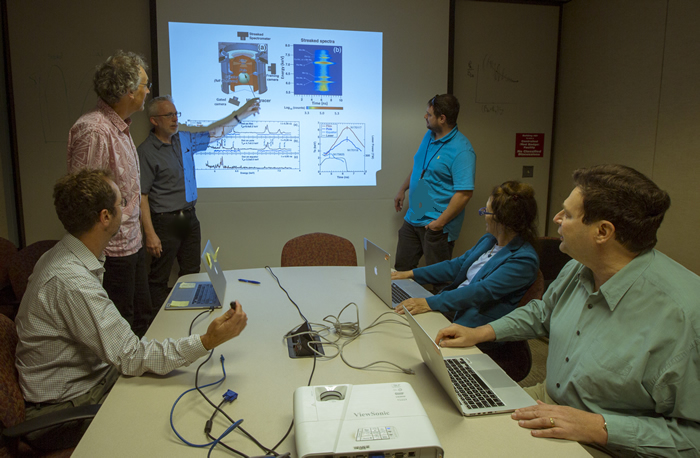 Members of the team studying energy flow in NIF hohlraums meet to discuss experimental results (from left): Oggie Jones, Klaus Widmann, John Moody, Dan Thorn, Marilyn Schneider, and Nino Landen. Credit: Jason Laurea
Members of the team studying energy flow in NIF hohlraums meet to discuss experimental results (from left): Oggie Jones, Klaus Widmann, John Moody, Dan Thorn, Marilyn Schneider, and Nino Landen. Credit: Jason Laurea Energy flow is important, said LLNL physicist John Moody, because “the temperature affects how the laser beams propagate; colder plasmas will tend to absorb laser light, and hotter plasmas absorb it less.
“Understanding the temperature distribution inside the hohlraum and how that evolves in time,” he said, “gives us a good understanding of how the laser beams actually move within the hohlraum as they go to the wall and deposit their energy—how efficient that whole process is.” This effects the efficiency with which x-rays are produced and therefore how efficiently and symmetrically the capsule is driven.
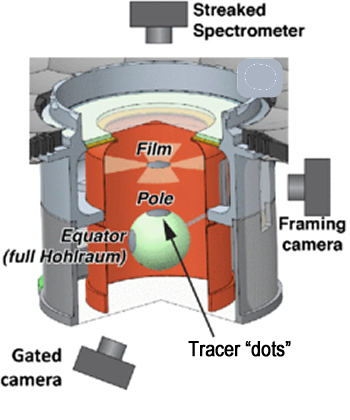 A sketch of the “ViewFactor” target used for two of the three starting locations of the tracer dots. NIF ViewFactor experiments use a hohlraum with the lower quarter removed to allow excellent diagnostic views of the hohlraum interior. The equatorial dot is studied in a full-sized hohlraum.
A sketch of the “ViewFactor” target used for two of the three starting locations of the tracer dots. NIF ViewFactor experiments use a hohlraum with the lower quarter removed to allow excellent diagnostic views of the hohlraum interior. The equatorial dot is studied in a full-sized hohlraum. Moody and his colleagues utilized a novel technique to determine hohlraum temperature and plasma flow by placing spectroscopic tracer “dots” on a thin film inside the hohlraum and on the surface of the target capsule. The spectroscopic measurements are used to create a low-resolution temperature “map” of hohlraum plasma conditions, providing the first multi-location tests of particle and energy transport physics in a laser-driven x-ray cavity such as a hohlraum.
The results of the three-year effort to develop the dot-spectroscopy experimental platform were reported in a Physical Review Letters paper published online on August 31. The paper discusses the role of kinetic effects, self-generated magnetic fields, and instabilities in causing spatially dependent heat transport in the hohlraum.
“Predictive capability is a big effort in the ICF program,” Moody said. “One aspect of this involves trying to calculate the behavior of the hohlraum.
“Much about those calculations hasn’t yet been tested,” he said. “Finding a way to test these models is important because it gives us insight into some of the limitations in the designs and shows us where we need to make adjustments and improvements. These measurements are providing some of the most constraining tests of our modeling capability inside NIF ignition hohlraums.”
The researchers said the experimental data is consistent with classical heat flow near the target capsule, but reduced heat flow near the laser entrance hole.
Moody credited the success of the experiments to a collaboration involving experimentalists—led by former LLNL physicist Maria Barrios, lead author of the Physical Review Letters paper, along with Lab physicists Marilyn Schneider, Duane Liedahl, Larry Suter, Oggie Jones, and Mark Sherlock—and the target fabrication experts who created the specialized targets used in the experiments, especially Target Engineer Steve Johnson of LLNL and Target Designer Scott Vonhof of General Atomics.
“One of the key things that made it possible was (the target fabricators’) willingness and ability to help us develop these targets,” Moody said. “There was a lot of trying things and looking at the data and saying, ‘Let’s make this change,’ and Target Fab would help us with that.” He also credited LLNL physicists Nino Landen and Bob Kauffman with overseeing the experiments and “guiding us to keep us on track.”
Contributing to the paper along with Barrios, Moody, Schneider, Liedahl, Suter, Jones, Sherlock, Landen, and Kauffman were Hui Chen, William Farmer, Joe Kilkenny, Jeremy Kroll, Steve Maclaren, Nathan Meezan, Abbas Nikroo, Daniel Thorn, and Klaus Widmann of LLNL; Javier Jaquez of General Atomics; and Gabriel Pérez Callejo of the Clarendon Laboratory at the University of Oxford in the UK.
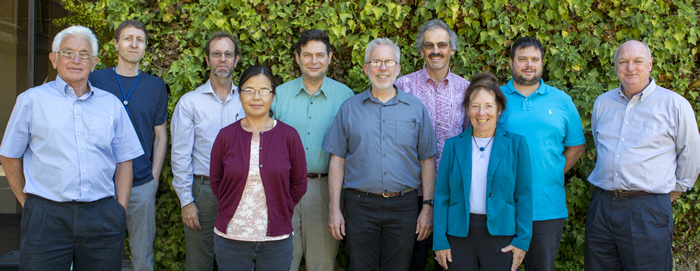 Members of the Dot Spectroscopy Team (from left): Joe Kilkenny, Mark Sherlock, Oggie Jones, Hui Chen, Nino Landen, John Moody, Klaus Widmann, Marilyn Schneider, Dan Thorn, and Bob Kauffman. Credit: Jason Laurea
Members of the Dot Spectroscopy Team (from left): Joe Kilkenny, Mark Sherlock, Oggie Jones, Hui Chen, Nino Landen, John Moody, Klaus Widmann, Marilyn Schneider, Dan Thorn, and Bob Kauffman. Credit: Jason Laurea —Charlie Osolin
NIF Reveals How Hydrogen Becomes Metallic in Giant Planets
Swirling dense metallic hydrogen dominates the interiors of Jupiter, Saturn and many extra-solar planets. Building precise models of these giant planets requires an accurate description of the transition of pressurized hydrogen into this metallic substance—a long-standing scientific challenge.
In a paper published on Aug. 16 by Science, a research team led by LLNL scientists describes optical measurements of the insulator-to-metal transition in fluid hydrogen, resolving discrepancies in previous experiments and establishing new benchmarks for calculations used to construct planetary models.
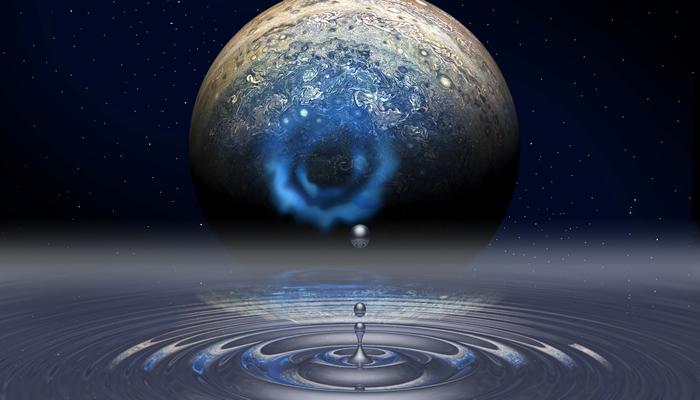 Unraveling the properties of fluid metallic hydrogen at the National Ignition Facility could help scientists unlock the mysteries of Jupiter’s formation and internal structure. Credit: Mark Meamber
Unraveling the properties of fluid metallic hydrogen at the National Ignition Facility could help scientists unlock the mysteries of Jupiter’s formation and internal structure. Credit: Mark Meamber The multi-institution team included researchers from the French Alternative Energies and Atomic Energy Commission (CEA), the University of Edinburgh, the University of Rochester, Carnegie Institution of Washington, the University of California, Berkeley, and The George Washington University.
Decades of research have revealed that high temperatures combined with high pressure progressively transform dense fluid hydrogen into an electrically conducting fluid. Surprisingly, computer simulations suggest that below 2,000 Kelvin (K), increasing the pressure could trigger a sudden insulator-to-metal transition. How much pressure is needed has been uncertain, because various theoretical models and numerical techniques experiments provide very different predictions.
“Our challenge was to design an experiment that could dynamically compress a sample of fluid hydrogen to several million atmospheres and do it gently enough (without a strong shock) that it remained cool, or below 2,000 K, to see which of the theoretical models was right,” said LLNL physicist Peter Celliers, lead author of the paper.
“We performed a series of experiments that provide a clear signature of the metallization transition,” Celliers said, “and from the data we have identified at what conditions in pressure-temperature space the transition is occurring. The results clearly show which models are right, which are not and a couple that are close. Choosing the right model is important for planetary scientists who are trying to predict the internal structure of Jupiter and Saturn.”
In addition, understanding the behavior of hydrogen under pressure is an important facet of the National Nuclear Security Administration (NNSA)’s efforts in inertial confinement fusion. Research in the areas of extreme temperatures, pressures, and densities also contributes to NNSA’s Stockpile Stewardship Program that helps ensure that the current and future nuclear stockpile is safe and reliable.
A series of five experiments was conducted at NIF, the world’s largest and highest-energy laser. First, the researchers condensed a thin layer of cryogenic liquid deuterium (a heavy isotope of hydrogen) by cooling to 21 K (-422 degrees Fahrenheit). They created a sequence of reverberating shockwaves using 168 of NIF’s 192 laser beams, compressing the deuterium fluid to 600 GPa (6 million atmospheres, nearly twice the pressure at the center of the Earth) while keeping the temperature between 1,000 and 2,000 K.
The sample started completely transparent, but as the pressure rose, it became opaque before transforming into a shiny metal whose high optical reflectivity is a signature for high electrical conductivity. An optical diagnostic instrument called VISAR recorded the reflectivity of the sample and the Doppler shift in the reflected light beam to determine the pressure in the sample.
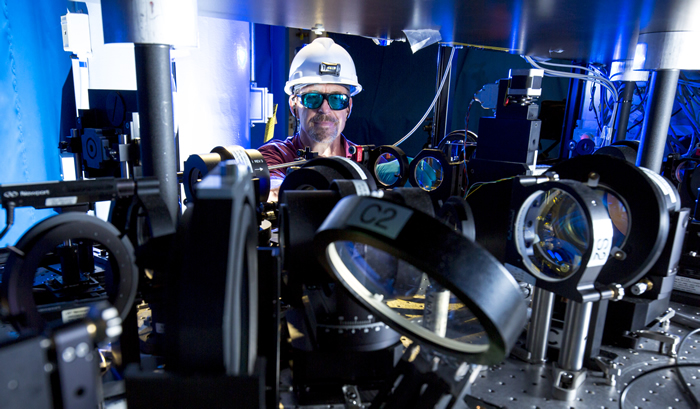 Responsible system engineer Gene Frieders inspects the VISAR (Velocity Interferometer System for Any Reflector) diagnostic. The VISAR instrument is an ultrafast optical diagnostic that uses a pulsed laser and interferometry to measure the velocity of the shock waves and characterize the optical properties of the fluid hydrogen during the insulator-to-metal transition. Credit: Jason Laurea
Responsible system engineer Gene Frieders inspects the VISAR (Velocity Interferometer System for Any Reflector) diagnostic. The VISAR instrument is an ultrafast optical diagnostic that uses a pulsed laser and interferometry to measure the velocity of the shock waves and characterize the optical properties of the fluid hydrogen during the insulator-to-metal transition. Credit: Jason Laurea “It’s like squeezing air and turning it into a shiny, light version of liquid mercury,” said Raymond Jeanloz, professor of astronomy and earth and planetary science at the University of California, Berkeley and a co-author of the publication. “Although exotic at Earth’s surface,” Jeanloz said, “metallic hydrogen is the main material inside most giant planets and stars.”
According to Celliers, the final results are a determination of the pressure and temperature at which the metallization occurs to compare with theoretical models. “From careful examination of the signals,” he said, “ we also learned new information about the refractive index and the absorption coefficient in the sample.”
“These results are a true experimental tour de force,” added LLNL physicist Marius Millot, a co-author of the paper, “and are particularly important because they provide a very stringent test on the different varieties of numerical simulations that one can use to predict the properties of planetary constituents at high pressure—necessary to model the internal structure and evolutionary processes of Jupiter and Saturn.
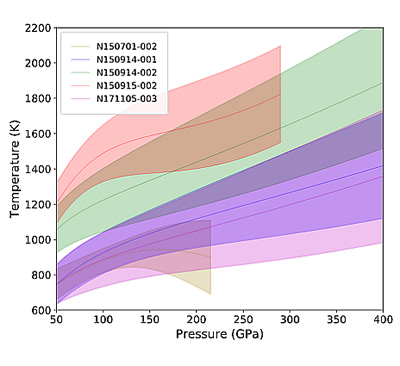 Estimated temperature-pressure paths for the five NIF experiments. The upper and lower bounds are estimated from the spread among the equation-of-state models; the solid curves are mean values.
Estimated temperature-pressure paths for the five NIF experiments. The upper and lower bounds are estimated from the spread among the equation-of-state models; the solid curves are mean values. “Now, thanks to the excellent performance and reproducibility of NIF and exquisite quality of data,“ he said, “our results bring new insight and verify predictions.”
The research was conducted as part of NIF’s Discovery Science Program, which allocates experimental time to researchers conducting breakthrough experiments in a variety of fields. This collaboration has been awarded additional time and is in the process of planning new experiments. Looking ahead, the team hopes to detect new exotic stages of hydrogen by pushing into higher pressures while maintaining lower temperatures.
“Because it is made of just one electron and one proton,” Millot noted, “understanding how the properties of hydrogen are modified by applying high pressures, which brings the atoms closer and closer to each other, is a great playground for condensed matter theoreticians.
“Hydrogen at high pressures and temperatures is the main constituent of gas giant planets and stars, so it is obviously important to study its properties if we want to understand where we come from, how the solar system was formed and evolved, etc,” he said. “For example, because fluid convection of metallic hydrogen generates the magnetic field of these planets, our data will be helpful in interpreting the amazing data collected by the Juno and Cassini missions.”
Celliers, Jeanloz, and Millot were joined by co-authors Dayne Fratanduono, Jon Eggert, Luc Peterson, Nathan Meezan, and Sebastien Le Pape of LLNL; Stephanie Brygoo and Paul Loubeyre of CEA; Stewart McWilliams of the University of Edinburgh; Alexander Goncharov of the Carnegie Institution of Washington; Ryan Rygg and Rip Collins of the University of Rochester; and Russell Hemley of The George Washington University.
The research was supported in part by the Laboratory Directed Research and Development program and the NIF team.
—Breanna Bishop
More Information
“Settling Arguments About Hydrogen With 168 Giant Lasers,” The New York Times, Aug. 16, 2018
Experiments Reveal New Details Inside NIF Implosions
Two new experimental techniques are shedding new light on the effects of hydrodynamic instabilities and asymmetries in the later stages of NIF inertial confinement fusion (ICF) implosions. The techniques are uncovering details about how fuel-capsule support structures and fill tubes may affect ignition, according to researchers from LLNL, General Atomics, and the Massachusetts Institute of Technology.
In a Physics of Plasmas paper published on Aug. 14, the researchers detailed how the experiments found “unexpected 3-D structures” caused by the ultrathin membranes that support the target capsule inside the hohlraum as NIF’s lasers fire (see “How NIF Targets Work”).
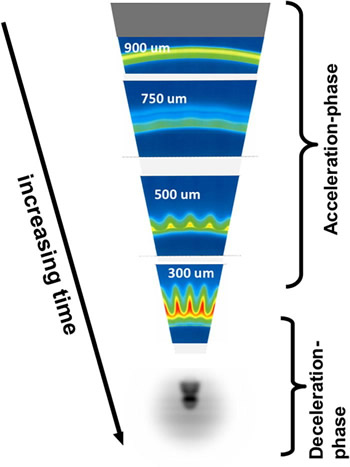 This simulation using LLNL’s HYDRA simulation code shows the growth of a pre-imposed ripple in density at the ablation front as the capsule is compressed from a radius of 900 microns to 300 microns. In the most damaging form of growth, a jet can penetrate into the hot spot during the deceleration phase, bringing with it high-atomic-number material from the shell. This can manifest in the x-ray images as bright spots; a simulated x-ray image using a 2-D HYDRA code with a single axial jet is shown.
This simulation using LLNL’s HYDRA simulation code shows the growth of a pre-imposed ripple in density at the ablation front as the capsule is compressed from a radius of 900 microns to 300 microns. In the most damaging form of growth, a jet can penetrate into the hot spot during the deceleration phase, bringing with it high-atomic-number material from the shell. This can manifest in the x-ray images as bright spots; a simulated x-ray image using a 2-D HYDRA code with a single axial jet is shown. The paper also detailed how a high-Z (high atomic number) dopant coating the capsule’s inner surface produces x-ray emissions used to measure the role of perturbations and radiative losses near the peak of ICF compression, “one of the major questions in ICF,” according to the paper.
While more is known about the acceleration phase of NIF implosions, the new experimental platforms should give scientists “a more complete picture of the hydrodynamic growth as we enter into the deceleration phase,” said LLNL physicist Louisa Pickworth, the paper’s lead author. “That’s very important because it tells us the state of the (target capsule) shell and the quality of our implosions.”
Pickworth provided the paper as part of an invited presentation at the American Physical Society Division of Plasma Physics in 2017. The paper also was an extension of research presented in earlier papers, including one from 2016 published in Physical Review Letters about measuring instabilities in NIF implosions at peak velocity.
Pickworth and many LLNL colleagues, including Bruce Hammel and Vladimir Smalyuk, have long studied ways to measure the deceleration stage of ICF implosions after NIF’s laser beams heat the inside of a hohlraum to more than three million degrees Celsius, triggering the fusion of hydrogen atoms in a tiny target capsule fueled with the hydrogen isotopes deuterium and tritium. Ongoing research on various fronts is trying to better understand hydrodynamic (fluid) instabilities, which have been shown to reduce neutron production during ICF experiments.
For one technique, the researchers added a small amount of argon to the gas fuel mixture inside the capsule to “self-backlight” the shell to enhance images of perturbations near peak velocity and into the deceleration phase.
The technique is analogous to a light bulb revealing the textures and folds of a lampshade by providing illumination from the inside, Pickworth said. The x-ray source inside the capsule “allows us to see density distribution in a portion of the shell,” she said. “It’s an important step forward in a very complicated field of inertial confinement fusion,” Smalyuk added.
Using this technique, experiments with pre-imposed perturbations showed up to a 7,000-times growth in the areal density of hydrodynamic instability, “the largest ever observed in ICF implosions,” according to the paper. There was also a difference between the growth shown on the capsule’s equator compared to its pole, “possibly pointing to the different amount of pre-heat between these two directions,” the paper said.
In addition, the researchers made another discovery.
“These experiments discovered unexpected three-dimensional structures originating from the capsule support structures,” the report said. “These new 3-D structures became one of the primary concerns for the indirect drive ICF program that requires their origin to be understood and their impact mitigated.”
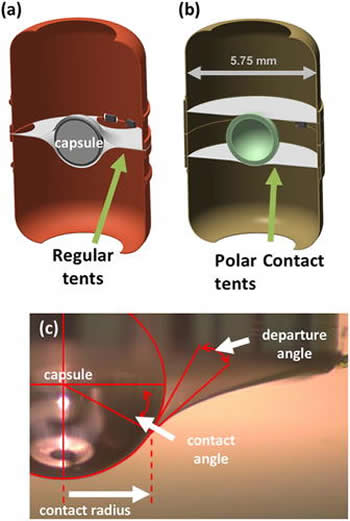 A schematic of the capsule support system, the “tents,” for standard tents (a) and polar contact tents (b). The departure angle from the capsule of the tent is shown in (c) with the contact radius indicated. In the polar contact tents, the contact radius is reduced.
A schematic of the capsule support system, the “tents,” for standard tents (a) and polar contact tents (b). The departure angle from the capsule of the tent is shown in (c) with the contact radius indicated. In the polar contact tents, the contact radius is reduced. In the second technique, which complemented the first, researchers used a high-Z dopant in the inner layer of the capsule. This method was developed to visualize and diagnose problems caused if a “catastrophic growth” were to launch large amounts of ablator material into the hot spot that might otherwise be hard to distinguish during the deceleration phase.
“This made it possible to clearly visualize the temporal evolution of high-mode perturbations, including the tents and fill tubes, as well as low-mode asymmetries that affect the overall shape of the implosion,” the report said.
The method also allowed studies of how much those disturbances reduced neutron yield.
Testing Tents
The researchers then applied this method to tests of new polar contact tents, part of months-long efforts to counter the undesirable distortions caused by the gossamer-thin membranes that support the target capsule inside the hohlraum. Those include using 43-nanometer-thick, carbon-coated polyimide foil that comes in contact with the capsule at its top and bottom poles. This method was designed to reduce the contact area between the tents and the capsule.
The researchers expected to see a “small circular region” at the points where the tents were in contact with the capsule, Pickworth said. “What we didn’t expect to see is a radial pattern. We saw this fractured, cobweb image.”
The radial pattern suggested that the tent, designed to be stiff enough to support the capsule, either bent or fractured into segments, the paper said. Nevertheless, more recent implosions with polar contact tents showed improved neutron yield performance, which warranted the further development of that tenting method, the paper said.
“It’s a work in progress,“ Pickworth said. Click here for a separate Physics of Plasmas paper by Hammel and colleagues providing more details on the polar contact tent studies.
Pickworth, Hammel, and Smalyuk were joined on the paper, “Development of new platforms for hydrodynamic instability and asymmetry measurements in deceleration phase of indirectly driven implosions on NIF,” by LLNL colleagues Harry Robey, Riccardo Tommasini, Laura Benedetti, Laura Berzak Hopkins, David Bradley, Matthew Dayton, Sean Felker, John Field, Steven Haan, Benjamin Haid, Robert Hatarik, Edward Hartouni, Dean Holunga, Nobuhiko Izumi, Steve Johnson, Shahab Khan, Thomas Kohut, Nino Landen, Sebastien Le Pape, Andrew MacPhee, Edward Marley, Nathan Meezan, Jose Milovich, Sabrina Nagel, Abbas Nikroo, Arthur Pak, Bruce Remington, Howard Scott, Paul Springer, Michael Stadermann, Curtis Walters, Klaus Widmann, and Warren Hsing, along with Martin Hoppe Jr. and Neal Rice of General Atomics and Richard Petrasso and Brandon Lahmann of MIT.
—Benny Evangelista




